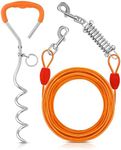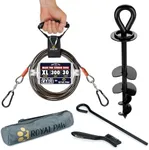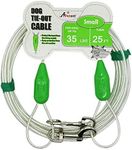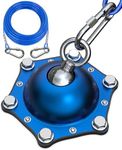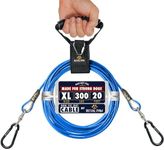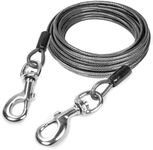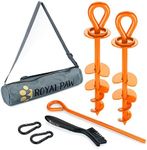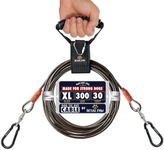Buying Guide for the Best Tie Out For Dogs
Choosing the right tie-out for your dog is essential to ensure their safety, comfort, and freedom while they are outside. A tie-out allows your dog to roam within a designated area without the risk of running away or getting into dangerous situations. When selecting a tie-out, consider the size, strength, and behavior of your dog, as well as the environment where the tie-out will be used. Here are some key specifications to consider when picking the best tie-out for your dog.LengthThe length of the tie-out determines how much freedom your dog will have to move around. A longer tie-out allows for more exploration, while a shorter one keeps your dog closer to a specific area. For small yards or spaces, a tie-out of 10-15 feet may be sufficient. For larger areas, consider a tie-out of 20-30 feet or more. Choose a length that provides enough space for your dog to move comfortably without getting tangled or reaching unsafe areas.
Weight CapacityThe weight capacity of the tie-out indicates how much weight it can safely handle. This is crucial to ensure that the tie-out can withstand the strength and size of your dog. Tie-outs are typically rated for small, medium, or large dogs. For small dogs (up to 25 pounds), a tie-out with a lower weight capacity is suitable. Medium dogs (25-50 pounds) require a stronger tie-out, while large dogs (over 50 pounds) need the most robust options. Always choose a tie-out that exceeds your dog's weight to ensure safety.
MaterialThe material of the tie-out affects its durability and strength. Common materials include steel cable, nylon, and chain. Steel cables are strong and resistant to chewing, making them ideal for strong or determined dogs. Nylon tie-outs are lightweight and less likely to cause injury if your dog gets tangled, but they may not be as durable. Chains are very strong but can be heavy and may cause injury if your dog gets tangled. Consider your dog's behavior and strength when choosing the material.
CoatingSome tie-outs come with a protective coating, such as vinyl or plastic, which can prevent rust and wear. This is especially important if the tie-out will be exposed to the elements, such as rain or snow. A coated tie-out is more durable and less likely to cause injury to your dog. If you live in an area with harsh weather conditions, a coated tie-out is a good investment to ensure longevity and safety.
Swivel ClipsSwivel clips are the connectors that attach the tie-out to your dog's collar and to a stationary object. These clips should be strong and secure to prevent your dog from breaking free. Swivel clips allow the tie-out to rotate, reducing the risk of tangling. Look for heavy-duty clips that are easy to attach and detach but secure enough to keep your dog safe. If your dog is very active or strong, opt for clips that are specifically designed to handle high levels of stress.
Reflective FeaturesReflective features on a tie-out can enhance visibility, especially in low-light conditions. This is important for keeping your dog safe if they are outside during dawn, dusk, or nighttime. Reflective tie-outs are easier to see, reducing the risk of accidents. If you often let your dog out in the early morning or evening, or if your yard is not well-lit, a tie-out with reflective features is a smart choice.
